|
Saltwater fishing from the beach requires no license (fishing from a boat now does) but there are bag and size limits for many fish species.
Contact the Fisheries Department for more information Ph. (08) 9482 7333.
Regional offices in Pt. Hedland, Broome, Exmouth, Karratha, Carnarvon, Denham and the south west.
Freshwater fishing, Cray and abalone fishing/collecting and net fishing all require licenses.
Please DO NOT KEEP UNDERSIZE FISH, put them back and let them grow to spawning size so there will always be something to catch.
So many people I have met will take fish that are just undersized. Size limits are placed to give the fish you catch a chance to breed before
they are killed. Like wise please do not take fish that are exceptionally large. These fish are the breeding stock for future generations and
they should be preserved. There are now maximum size limits on some fish including on all cod species.
If you see people taking fish illegally report them to the authorities as they are ruining a great sport for everyone who does do the right thing.
Not sure about size and bag limits? Inquire at CALM or Fisheries offices or buy a good fishing book. Put back anything you don't want, and put it back
alive. Illegal fishing can be reported to Fishwatch on 1800 815 507.
Looking for great seafood recipes? Check out our free recipe site.
CHECK OUT OUR FISHING RELATED VIDEOS
IS THE FISH I CATCH SAFE TO EAT?
Firstly you have to know what sort of fish you have caught. If you are not familiar with the different species of fish then the photos below will help you identify
many of the more common fish caught in W.A. It is always a good idea to buy a good identification guide to fish so that you can find out what you have caught
and if it is edible.
There are some fish, like toad fish (known locally as blowies), that are highly toxic and can kill people if they eat them. Other fish have venomous spines
that can inflict severe pain. In some areas of Australia certain species of fish may contain ciguatera poison. This is caused by the things they eat and builds
up to dangerous levels in larger fish. The Chinaman fish, for example, is not eaten in Queensland because of the risk of this poison. In W.A. some people do
eat these fish with no ill effects so the danger may be regional.
As a general rule of thumb, never eat a fish that does not have scales. If it has spines then be very careful how you handle it. Rabbit fish or spinefoot have a
very nasty venom in their spines but they don't look very different to many other fish with non-venomous spines.
If you are not familiar with the different types of fish you can ask other people who are fishing nearby what you have caught and if it is safe to eat.
Water quality in Western Australia generally isn't an issue if you are fishing in the ocean. In rivers and lakes you need to be aware (especially in summer)
of any toxic algal bloom warnings. These are usually issued on the internet so it is a simple matter of doing a search with Google.
If you want to find out how to catch fish like these then read our Fishing tips page.
or you can have a look at our 'brag page'.
and don't forget to follow W.A.'s fishing regulations.
PHOTO GUIDE TO FISH IDENTIFICATION
Following is a series of photographs of some of the fish you might catch and our rating system on how good they are to eat.
Our rating system for eating fish:
* Basically Horrible
** Edible but poor
*** Good eating
**** Excellent
Name : Australian Salmon
Food Rating : *
Usually caught : From the beach with medium to heavy tackle and long beach rods.
Habitat : Open sea.
Found : South coast and south west.
Notes : Australian salmon are most often targeted as a sport fish as they fight well but they are not highly regarded as an eating fish.
They are mostly caught along beaches in the south or south-west of the state by anglers with long beach rods.
These fish are not actually salmon and are more closely related to Australian herring - which incidentally are not herring! Juvenile Australian
salmon are sometimes mistaken for Australian herring.
In the eastern states, Australian herring are known as Tommy rough.
Our Experiences : We don't actually target any species we don't want to eat so we have only ever caught immature specimens when fishing for whiting in estuaries.

Name : Barracuda and Military Seapike and other pike
Food Rating : **
Usually caught : From the beach or boats.
Habitat : Open sea and tidal creeks.
Found : Tropical waters.
Notes : Fast aggressive fish with lots of sharp teeth.
These are often caught on lures or with a moving bait.
Although they are not highly regarded as an eating fish, their flesh is white and not very fishy tasting.
Barracuda are the largest fish in this group, followed by the military seapike and striped pike.
Our Experiences : We have caught larger barracuda on fast moving lures and smaller pike of all sorts of different baits. We never deliberately
target these fish and often catch them when fishing for mackerel or some reef species.

Name : Barramundi
Food Rating : ***
Usually caught : From moving boats or by casting and retrieving baits.
Habitat : Open sea and tidal creeks.
Found : Tropical waters.
Notes : Barramundi have a status like no other fish in Australia. They are highly prized and many people extol their virtues as an eating fish.
Although their flesh is firm and white, it can be a bit on the bland side. Fish caught in the ocean are far more preferable for eating to those caught in rivers.
One of the reasons people like to catch a 'barra' is the legendary fighting prowess of the fish.
Barramundi are tropical species and can be caught along the north west coast as far south as Onslow BUT they are usually only in this 'southern' part
of their range during the hot season. They are found in the Kimberley all year round.
Our Experiences : Sadly none, we have never caught a barramundi.
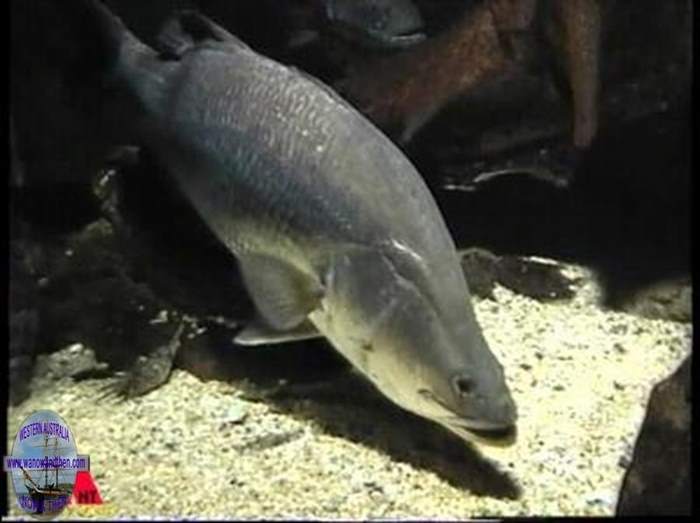
Name : Bream - Coral Monocle
Food Rating : *
Usually caught : From boats, rocky shoreline or mangrove creeks.
Habitat : Tidal creeks.
Found : Warmer waters.
Notes : Mostly caught as an incidental fish as they are not regarded as any good to eat.
Best to just throw them back.
Our Experiences : We have only rarely caught these fish, usually in creeks when fishing for yellowfin bream.
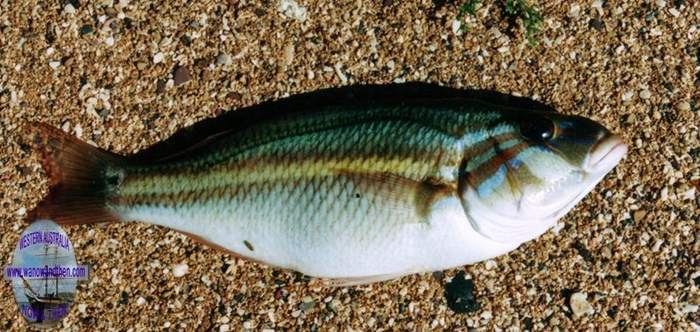
Name : Bream - Pikey
Food Rating : **
Usually caught : From boats, rocky shoreline or mangrove creeks.
Habitat : Tidal creeks.
Found : Tropical waters.
Notes : Pikey bream are probably the most wily of the bream family but are also not as good to eat as the yellowfin bream.
They like to inhabit mangrove lined creeks and are found along the northern coast of the state.
They are also called Northwest black bream.
Our Experiences : We always catch these in muddy mangrove creeks. They take a variety of baits and often they only bite very lightly.
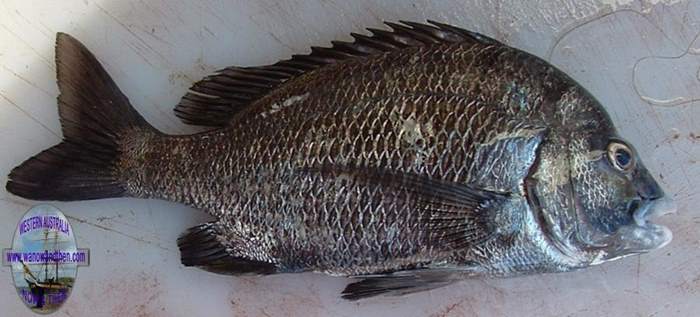
Name : Bream - Yellowfin
Food Rating : ****
Usually caught : From boats, rocky shoreline or mangrove creeks.
Habitat : Tidal creeks and offshore reefs.
Found : Warmer waters.
Notes : Yellowfin bream, unlike pikey bream, are often found on offshore reefs as well as in the same habitat as pikey bream.
They can be fussy feeders but when the mood takes them they can bite hard and aggressively.
Our Experiences : We have caught these fish from Kalbarri and places further north. They will take all sorts of bait but seem to love
fresh prawns but will even small fresh fillets of fish on ganged hooks. We are often surprised to catch them on offshore reefs when we are trying to
catch emperor. Big bream put up a very good fight.
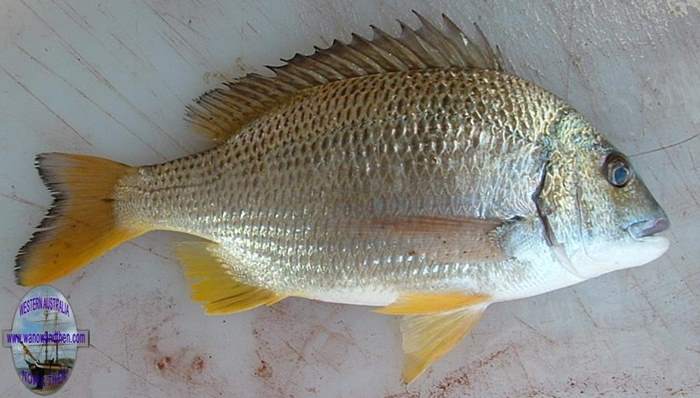
Name : Butterfish or Striped Scat
Food Rating : *
Usually caught : From boats, rocky shoreline or mangrove creeks using small hooks.
Habitat : Tidal creeks.
Found : Warmer waters.
Notes : These are also caught as an incidental fish as they are not regarded as any good to eat. They also have very long sharp spines
so take care when handling.
These are known as striped butterfish but are more properly called striped scat as there are many fish referred to as butterfish.
Our Experiences : We catch these from time to time when fishing in creeks in the north west. They have small mouths so are most often
caught when we are using small hooks.
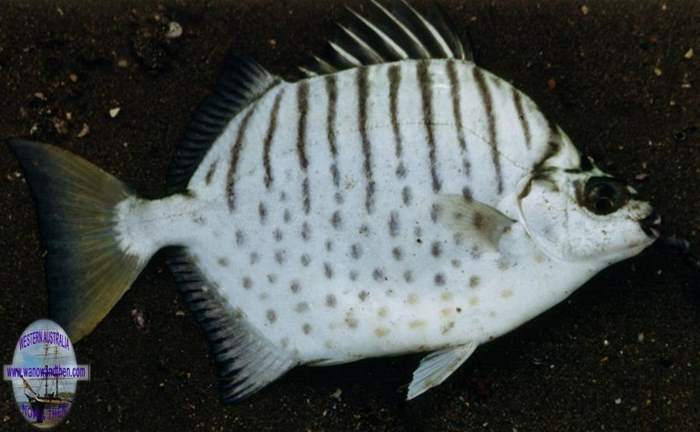
Name : Cardinal fish
Food Rating : Too small
Usually caught : From boats over reef with small hooks.
Habitat : Offshore reef..
Found : Warmer waters.
Notes : Too small to eat, these are often caught on baits that look much too large for them to tackle.
Best to throw these back.
Our Experiences : Rarely caught but when they are it is always on baits meant for much bigger fish.
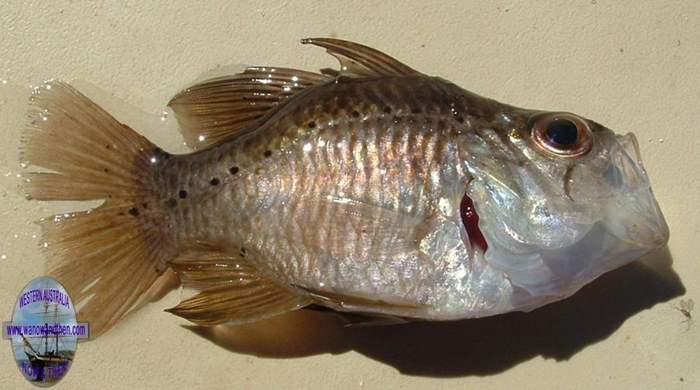
Name : Catfish
Food Rating : **
Usually caught : From boats or from mangrove lined shore with light to medium weight tackle.
Habitat : Creeks and mangrove areas.
Found : Warmer waters.
Notes : There are a number of different types of catfish but these ones tend to inhabit mangrove lined water ways in the north of the state.
Some people enjoy eating them but we try not to handle them due to the three very sharp spines on the dorsal and pectoral fins.
Catfish are mostly bottom feeders and will take just about any kind of bait. The larger specimens will fight quite hard at first but give up quite quickly.
Our Experiences : We catch LOTS of these in mangrove creeks in the north west. After dropping one on my leg and having the spine go right in, these days
I throw them back very quickly. They eat just about anything that gets down to the bottom of the creek. They tend to follow the tides in and out.

Name : Chinaman fish
Food Rating : Read the text.
Usually caught : From boats over reef with strong lines and medium to large sized hooks.
Habitat : Offshore reef.
Found : Warmer waters.
Notes : In Queensland these are regarded as too dangerous to eat as they may contain the toxin known as Ciguatera.
In W.A. they seem to be free of this are are often eaten. Our advice is to take care, especially with larger specimens. If in doubt just put them back.
Our Experiences : Although we haven't caught many of these fish, when we do it has always been over offshore reefs. They are caught when we are after
large cod or coral trout and usually take big baits.
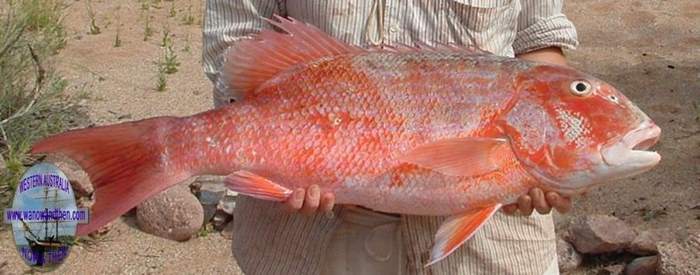
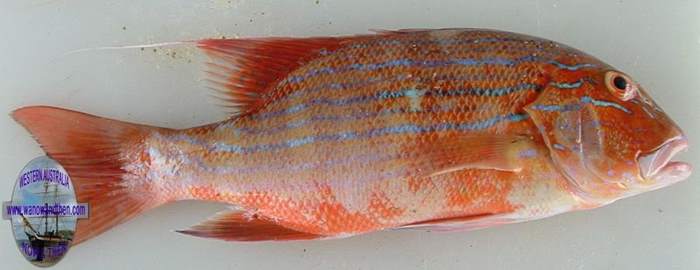
Name : Cod
Food Rating : ****
Usually caught : From boats or from mangrove lined shore with strong lines and medium to large sized hooks.
Habitat : Creeks and mangrove areas and offshore reefs.
Found : Warmer waters.
Notes : There are too many types of cod to list here but we have put a few different pictures below to give you some idea of the different
appearances they can have.
They are VERY good eating if they are caught in the open sea but cod from creeks (especially larger ones) tend to taste muddy and we think are not worth taking.
Even though cod are good to eat, we tend to release most of those we catch because they are VERY difficult to kill and we don't like causing undue suffering.
Along with minimum sizes, cods now have maximum sizes as well. Please check the current rules from Fisheries if you are unsure.
Our Experiences : Cod are often caught in creeks and offshore reefs. They seem to inhabit a territory and if they live in a creek they develop a strong muddy taste.
They eat all sorts of bait and will tackle just about any sized bait.
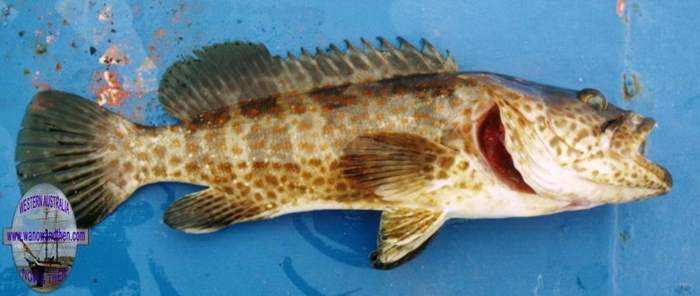
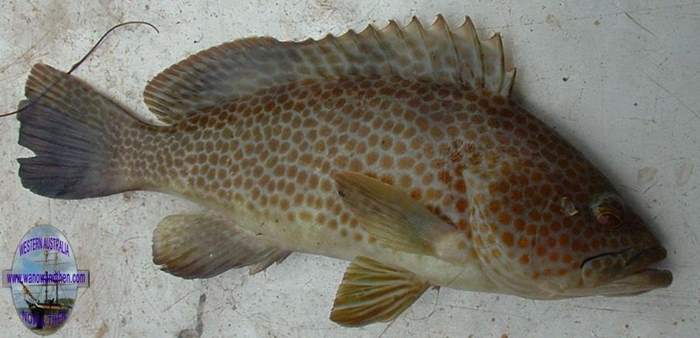
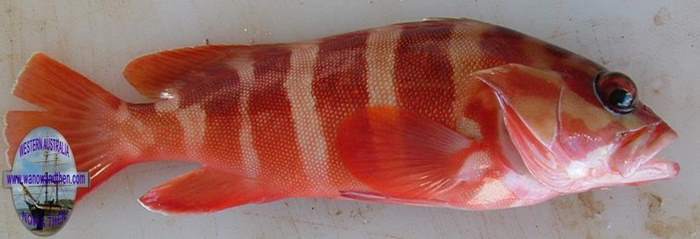

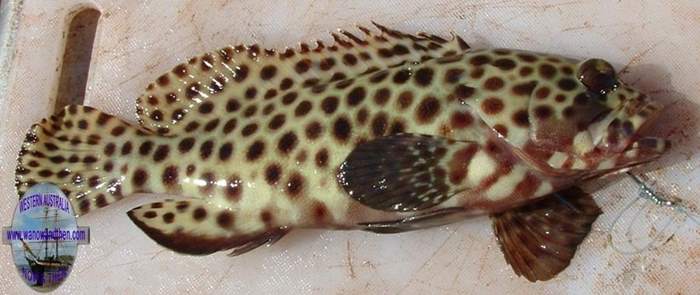
Name : Coral trout
Food Rating : ****
Usually caught : From boats over offshore reef with strong lines with traces and ganged hooks.
Habitat : Reef.
Found : Warmer waters.
Notes : Next to barramundi, coral trout may be the most sought after fish along the north coast.
They are excellent eating and they fight very hard. They are also quite rare so please obey size and bag limits.
Our Experiences : We have targeted these fish by using whole bait fish (sardine sized) floated down onto a reef on a ganged hook.
This method has had quite some success.

Name : Dart
Food Rating : **
Usually caught : With light to medium tackle and small to medium sized hooks.
Habitat : Shoreline.
Found : Warmer waters.
Notes : Most of the dart we have caught have been smaller varieties but the one pictured was very big indeed.
They aren't the best eating and compare with the taste and texture of trevally.
Our Experiences : We have always caught these when fishing off the beach. If you swim along anywhere along the coast near
Ningaloo, chances are you will see these fish hanging around your feet.

Name : Emperor or Northwest snapper
Food Rating : ****
Usually caught : With strong weighted lines and medium sized hooks.
Habitat : Reef.
Found : Warmer waters.
Notes : My absolute favourite eating fish. Emperor are a real fighting fish and even small ones will make you work hard.
There are many type of emperor but the ones most often caught (and targeted) are blue lined and spangled.
Considered one of the best eating fish in the sea. Good battered and deep fried. They are known collectively as North West Snapper but they
are not snapper at all. Size limits vary for different types of Emperor so you need to be able to tell blue lined and spangled emperor from all the
other types.
Our Experiences : We have gone after these fish in a big way because we regard them as just about the best fish to make fish and chips with.
Because we fish mostly near Karratha, we have caught the blue lined variety but those fishing further south usually catch spangled emperor.
So far we have caught almost all emperors on octopus, squid or fillet strips. Usually they are near reefs and close to the bottom. As a rule of thumb,
the deeper the water, the bigger the emperor. The usual rig has been a big suicide hook and a medium line (usually without a trace). They can be
finicky feeders like bream and the bigger ones can give the lightest bites.
Use the mouse to hover over any picture to see the ID.
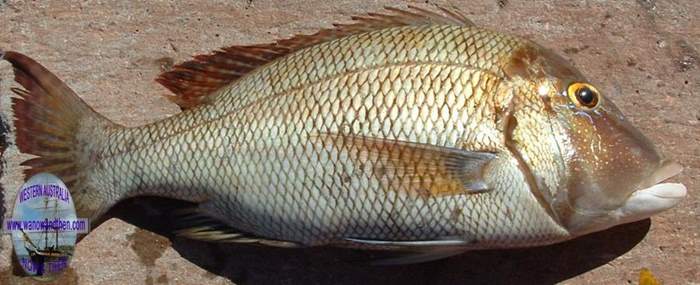
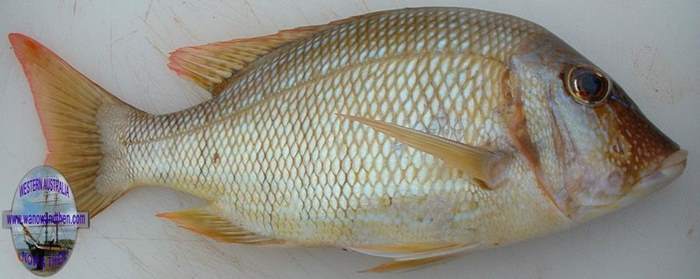
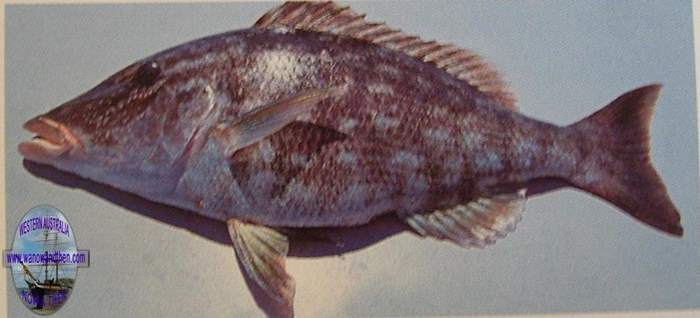
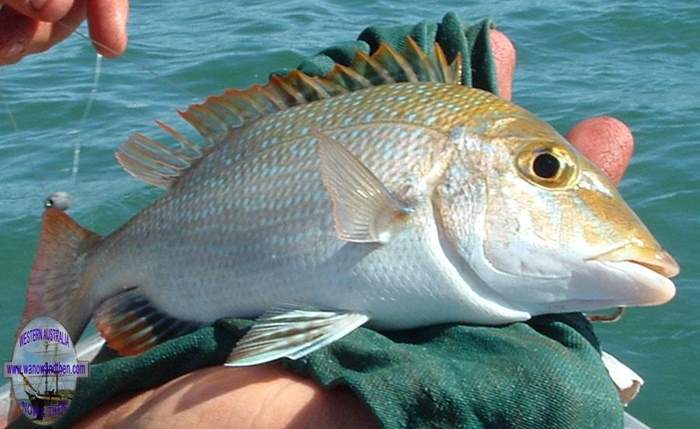
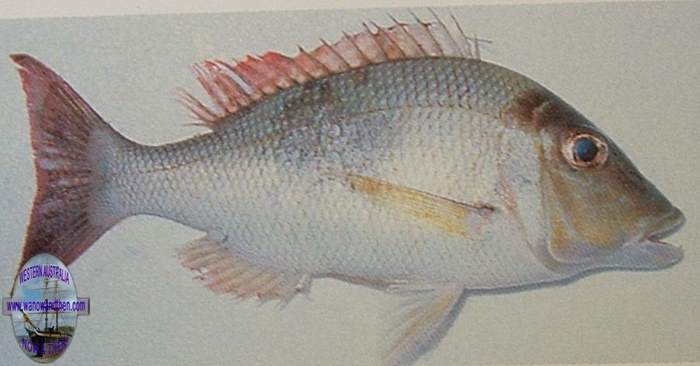
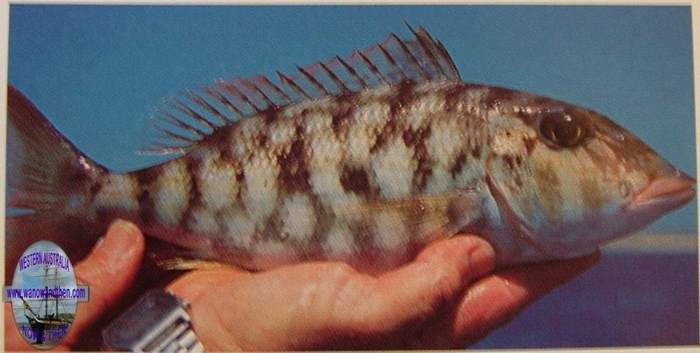
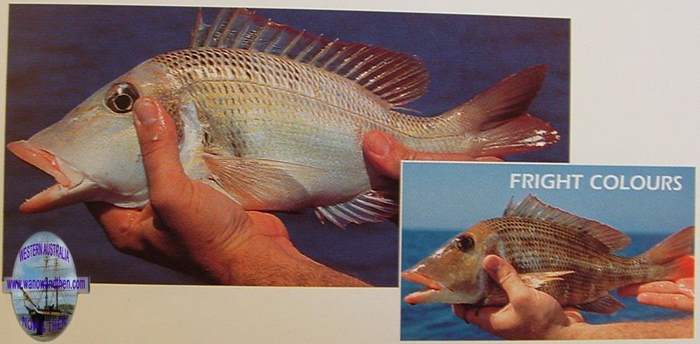
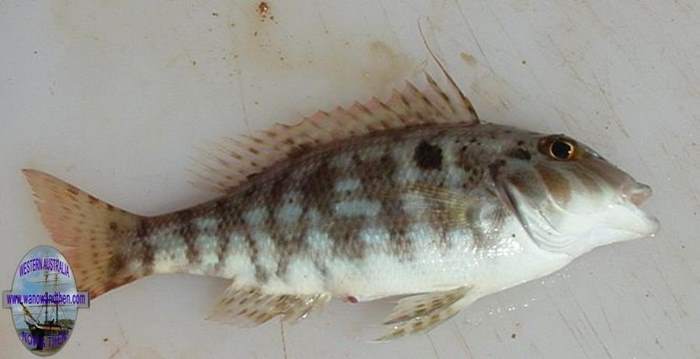
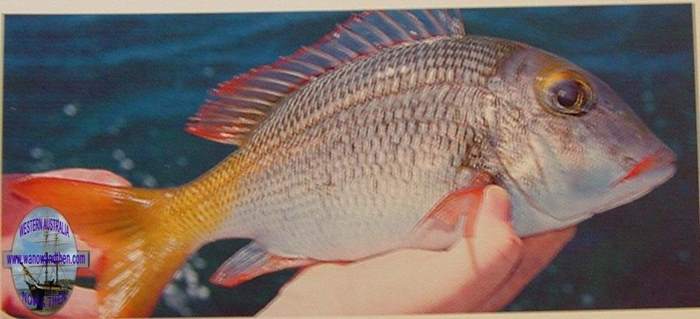
Name : Flathead
Food Rating : ****
Usually caught : By drift fishing along the bottom.
Habitat : Estuaries, sand and broken reef.
Found : All along the coast.
Notes : A bottom dwelling fish that lies in wait for small fish and prawns, flathead are often caught with drifting baits and small lures.
They are a good eating fish, even if they are a bit odd to fillet.
Beware of the razor sharp gill rakers on these fish. Use gloves or a rag when handling them.
Our Experiences : We don't target flathead but often catch them when fishing for other species. We have caught them most often when drift fishing
over weed beds that contain large sandy patches but have also caught a few when fishing for snapper over reef.



Name : Flounder
Food Rating : ****
Usually caught : By drift fishing along the bottom.
Habitat : Sand with weed nearby.
Found : Southern waters.
Notes : Lives in a similar manner to flathead (above) by lying in wait on the bottom and ambushing their prey.
They are regarded as a good eating fish but are even more difficult to fillet than flathead. For this reason many people don't bother to fillet them.
Our Experiences : Caught in a similar fashion for flathead by drifting over sandy patches near weed beds. Small baits like prawn on a small hook
have been effective.
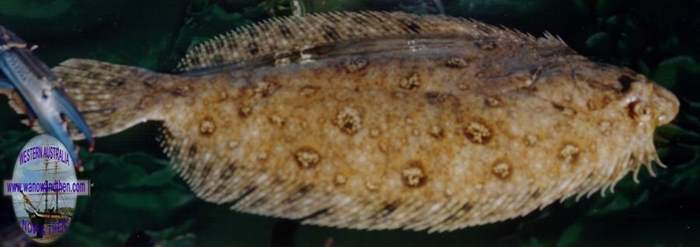
Name : Garfish
Food Rating : ***
Usually caught : On light lines with long shank hooks.
Habitat : Just about anywhere on the surface.
Found : All along the coast.
Notes : We love garfish, not as you might think, to eat, which some people do but we love them as bait.
We use garfish to catch just about everything else we fish for and they are probably the most successful bait we use.
We fillet them or use them whole depending on what we are fishing for.
Our Experiences : A very light line (4lb) and a very small long shank hook. We use a berley mix kneaded to a soft doughy
consistency, the gardies love it. (Recipe: Tuna cat food, tuna or fish oil and flour.)
They also like small strips of squid but for some reason don't like octopus very much.
We catch gardies as bait for bigger fish and get them from the boat or from the beach.
They will almost always come in when we have a berley stream going. Many people use floats to catch gardies but we think they
make life more difficult.
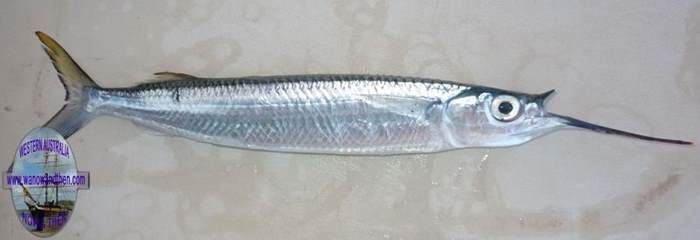
Name : Grinner
Food Rating : *
Usually caught : Caught over sand or reef in the open sea.
Habitat : Reef and sand areas in the open sea.
Found : Warmer waters.
Notes : Grinners are good for bait but just about nothing else. They are only good as bait the same day you catch them as their flesh
gets soft and unusable.
Our Experiences : Most times we have caught these over sand near reefs but they sometimes explode into plague proportions and then we have caught them
on big lures near the surface. They take anything offered when conditions are like this and become a huge pest as they take bait meant for other fish.

Name : Grunter - Yellow tailed
Food Rating : *
Usually caught : On light lines with small hooks.
Habitat : Reef and sand areas and in tidal creeks.
Found : Warmer waters.
Notes : These fish are just nuisance value as they are not good eating and don't seem to be much good as bait either.
Our Experiences : We most often catch these when fishing for garfish in shallow sandy areas near rocks. We consider them to be a pest
as they can congregate in great numbers and prevent other fish from taking the bait.
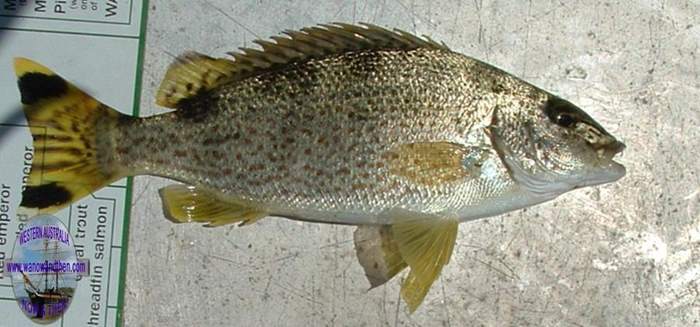
Name : Hardyhead
Food Rating : Too small
Usually caught : By throw nets from the shore or jetty.
Habitat : Over sand or sometimes in great numbers around jetties.
Found : Warmer waters.
Notes : No good for eating but these fish make excellent bait.
Our Experiences : We catch these using a throw net but they can be hard to find.
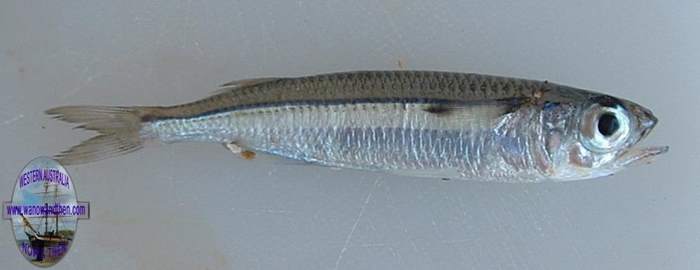
Name : Herring
Food Rating : **
Usually caught : From a boat or jetty.
Habitat : Over weed or sand in the open sea.
Found : Southern waters.
Notes : A favourite fish to catch for many people, these herring are not true herring at all and are actually a type of perch.
In the eastern states they are referred to as Tommy rough.
They are not usually large fish (although they can grow to be over 40cm) but they are aggressive feeders and are often caught
on small lures.
Our Experiences : We often catch herring from a boat and most often when a bait or lure is being moved. They appear to prefer a moving target.
We seem to do best when the weather is a bit rough as the fish seem to go crazy at these times and bite on anything we throw them.
Light lines on or just below the surface with prawn or mussel meat do well as baits.

Name : Herring - Giant
Food Rating : *
Usually caught : As incidental catch in a net or on lures.
Habitat : Over shallow sandy areas.
Found : Southern waters.
Notes : Not an eating fish, people catch these mostly for their fighting ability.
They can be caught in the Swan River but are more often found in coastal waters.
Our Experiences : We have caught small specimens of these fish as an incidental catch when we have been set netting for mullet.
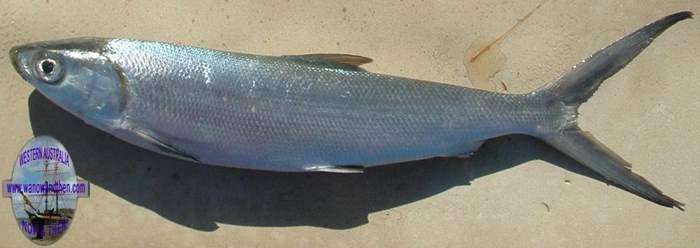
Name : Herring - Wolf
Food Rating : *
Usually caught : From a boat when fishing near the surface.
Habitat : Tidal creeks and coastal waters.
Found : Northern waters.
Notes : These are much too bony to bother eating but they are excellent bait.
Although we have usually only caught small specimens of these fish, they do grow to a metre in length and they have large sharp teeth.
Our Experiences : We usually catch these from a boat when fishing for bream or snapper. We have caught them in tidal creeks and over near shore reefs.

Name : Javelin fish
Food Rating : ***
Usually caught : From a boat or jetty.
Habitat : Tidal creeks and coastal waters.
Found : Northern waters.
Notes : A good eating fish that puts up quite a fight when hooked.
Our Experiences : We have caught these north from Kalbarri and if you can catch one that is of legal size, you will find they are very good eating.
We have most often caught them near the mouths of tidal creeks when fishing for bream or mulloway.

Name : Jobfish
Food Rating : ***
Usually caught : From a boat.
Habitat : Tidal creeks and coastal waters.
Found : Northern waters.
Notes : We haven't caught enough of these fish to make any comments on what they are like to eat.
Our Experiences : The only one we have caught is the one pictured and we are not 100% sure of its identity. The closest
ID we could find was called a sharp toothed jobfish.
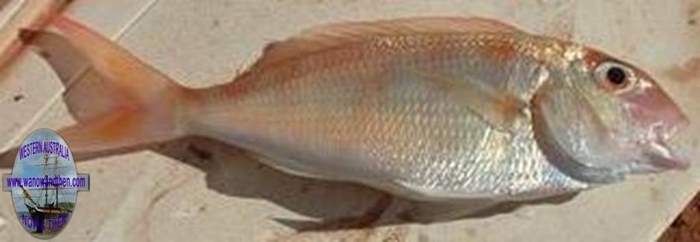
Name : Leatherjacket
Food Rating : ***
Usually caught : From a boat with light tackle and small hook.
Habitat : Over weed beds and on reefs.
Found : Southern waters.
Notes : These are popular fish to eat but we have never taken one for food so can't comment first hand. We simply thought there was more head than
body and let the fish go.
Our Experiences : This is the only leatherjacket we have ever caught. There are a number of different types and this was caught while fishing for whiting over weed beds.

Name : Long Tom
Food Rating : **
Usually caught : From the shoreline or near the shore from a boat.
Habitat : Usually open sea near the surface.
Found : Northern waters.
Notes : Although they are not bad eating they tend to have too many bones for most people to bother with.
Another thing they also have lots of is sharp teeth so it is best to avoid letting one get hold of you.
Our Experiences : We often catch these when we are fishing from the beach trying to catch garfish - which I presume they eat. Some varieties
grow quite large and can be caught further out to sea from boats.

Name : Mackerel - Blue
Food Rating : **
Usually caught : From the shoreline or near the shore from a boat.
Habitat : Usually open sea near the surface.
Found : Northern waters.
Notes : These are also called slimy mackerel and although they are a fairly strong tasting fish, like most other mackerel, they are
delicious when smoked.
Immature blue mackerel congregate in large schools and will literally bite on anything when they are in a feeding mood. Larger mackerel
are usually caught further offshore.
Our Experiences : Most of the time we catch these from a boat in inshore waters. They seem to like to feed near the surface and are often
caught when we are fishing for herring. Like herring, they are attracted to moving baits.
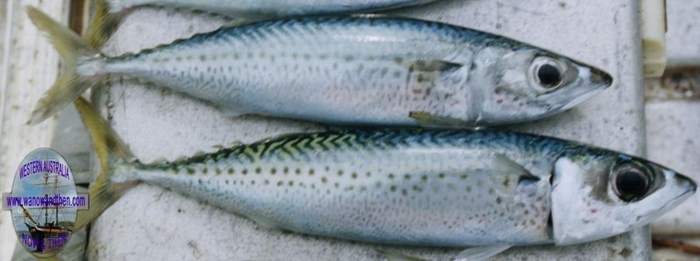
Name : Mackerel - Spanish
Food Rating : ****
Usually caught : From rocky shoreline or from boats.
Habitat : Usually open sea but sometimes near the mouths of rivers.
Found : Mostly Northern waters but they have been caught in far southern waters too.
Notes : Unlike other mackerel these fish have firm white tasty flesh and are excellent either pan fried in butter or cut into steaks and put on the BBQ with
some garlic and lemon pepper.
They grow very large and they fight like demons. Watch your fingers when handling them.
Our Experiences : We have always caught these from a boat using a float line with a strong trace and ganged hooks. Usually a whole garfish is used for bait.

Name : Mackerel - Spotted
Food Rating : ***
Usually caught : From rocky shoreline or from boats.
Habitat : Open sea.
Found : Northern waters.
Notes : These are far more abundant than Spanish mackerel (above) and are not quite as good to eat. They are also known as Queensland school mackerel.
We suggest using a smoker to cook them as they are at their best done that way. They are best eaten fresh as the flesh tends to dry out
after freezing.
Our Experiences : We catch these when fishing for Spanish mackerel from a boat using a float line with a strong trace and ganged hooks. Usually a whole garfish is used for bait.
Like Spaniards, they have sharp teeth.

Name : Mangrove Jack
Food Rating : ***
Usually caught : Either from the shore or from a boat.
Habitat : As the name suggests, near mangroves.
Found : Northern waters.
Notes : An amazing fighting fish that is as wily as they come. They are very good at dragging your line around branches, roots and jetty pylons. Larger Jacks
have learned over time how to get off fishing lines and they are difficult to catch.
Jacks are highly prized fish and are good eating. They are very similar in appearance to redtail perch (see below).
Our Experiences : Catching Jacks is fraught with challenges and we have lost many big ones around jetty pylons. Most of the time we catch them when fishing for
bream or cod around mangrove lined shores.
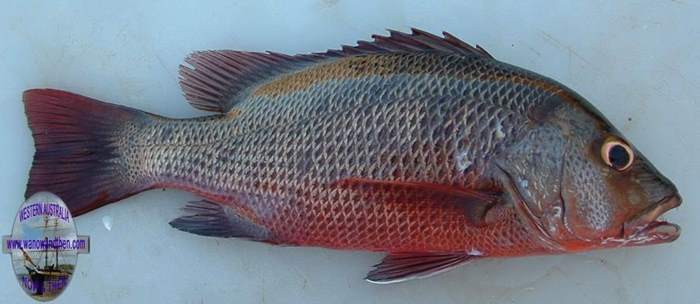
Name : Mullet
Food Rating : ** - ***
Usually caught : With nets.
Habitat : Mangrove areas and also shallow sandy bottomed areas.
Found : All waters.
Notes : The big silver sea mullet are quite good eating but any caught in estuaries are usually muddy and only good for bait.
Mullet have soft mouths are are only rarely caught on fishing lines. They are most often caught by set-netting but this has been outlawed in most of the
state so it is now very difficult to catch them.
Our Experiences : Bush Bay south of Carnarvon has been one of the few places left that you can legally use a set net. We have caught quite a few
mullet there and the sea mullet are good eating. Years ago we also caught them in the Harvey Estuary but those fish were not nice eating at all.

Name : Mulloway
Food Rating : ***
Usually caught : With heavy lines and medium to large hooks from the shore or boat.
Habitat : Mangrove areas, creeks, rivers and sandy shorelines.
Found : Western shorelines from Shark Bay south.
Notes : Good fighters when the mood takes them, mulloway have white firm flesh but can be a bit tasteless..
Small mulloway are often called 'soapies' for the unpleasant texture of their flesh.
A similar looking fish, called a black Jewfish, inhabits northern waters. The Jewfish is also called a northern mulloway.
Our Experiences : Many people fish for mulloway at night and we have caught the odd small one in set-nets at night. The large ones we have
caught during the day and on baits that vary from a small bit of octopus to a big piece of fish fillet. We have caught them at Kalbarri and Bush Bay
but they extend further south as well.
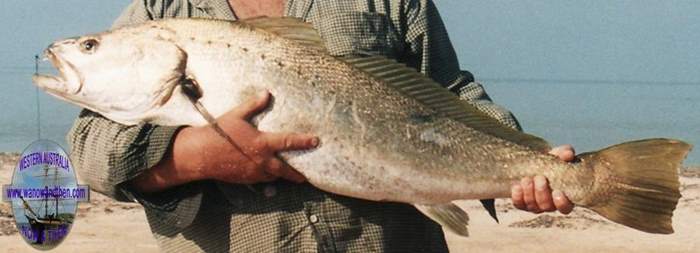
Name : Perch - Fingermark
Food Rating : ***
Usually caught : With medium weight lines and medium sized hooks.
Habitat : Reefs.
Found : Northern waters.
Notes : Also called fingermark bream or golden snapper, these fish are very similar in eating quality and habits to the striped perch.
Another species called Moses perch is often mis-identified as Fingermark perch. Moses perch have a much more distinct spot and are usually
a more reddish colour.
Our Experiences : We have caught these over reefs and they are fast aggressive biters. They often take baits meant for emperors
as both fish live in the same habitat.
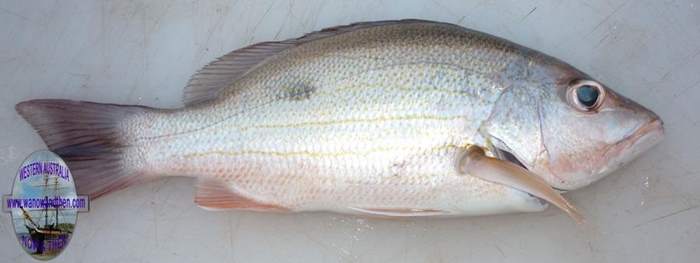
Name : Perch - Red tailed
Food Rating : ***
Usually caught : With light lines and small to medium sized hooks.
Habitat : Mangrove areas, creeks, reefs.
Found : Northern waters.
Notes : Often mis-identified as a Mangrove Jack (above) these perch are reasonable eating and quite good fighters for their size.
They seem to like octopus but will also take cubes of fish flesh and prawns.
Our Experiences : We haven't caught many of these but those we have were caught when we were fishing on reefs and trying to catch emperors.
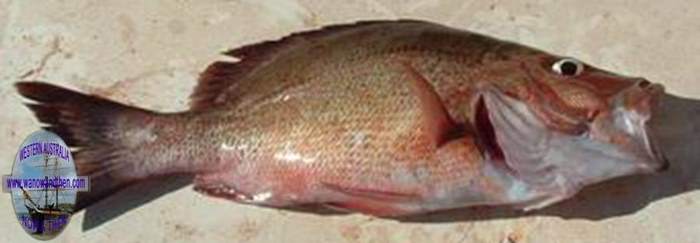
Name : Perch - Striped
Food Rating : ***
Usually caught : With medium weight lines and medium sized hooks.
Habitat : Reefs.
Found : Northern waters.
Notes : These are a popular fish to catch and their numbers have been declining for some time. Originally there were no size limites
and people took too many small fish. It may take some time for numbers to build back up to what they once were.
Good to eat and good fighters the 'stripey' is also known as Spanish Flag.
Our Experiences : We have caught these over reefs and they are fast aggressive biters. They often take baits meant for emperors
as both fish live in the same habitat.
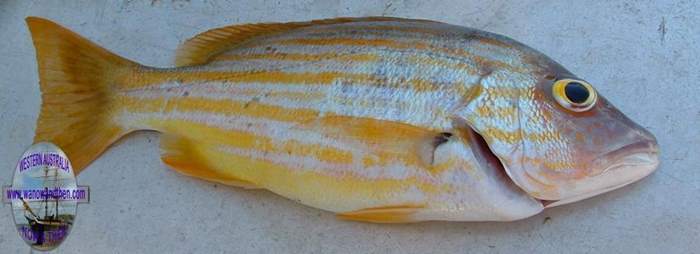
Name : Perch - Threadfin pearl
Food Rating : *
Usually caught : Incidental catch.
Habitat : Reefs.
Found : Northern waters.
Notes : Not considered to be an eating fish.
Our Experiences : Just caught by accident.
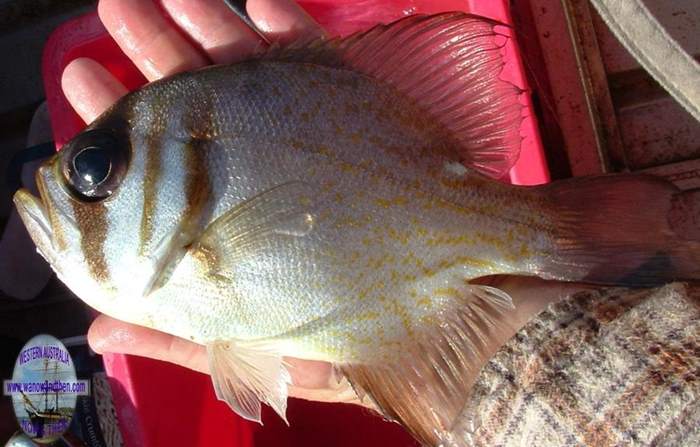
Name : Pike
Food Rating : ***
Usually caught : From boats with light gear.
Habitat : Reefs and creeks.
Found : Most open sea waters.
Notes : These little barracuda like fish are fun to catch and can be eaten.
They are also known as snook and there are a few different varieties.
Our Experiences : Generally we catch these fish when trying to catch garfish or sometimes they even take baits from down on a reef.
They can be great fun to catch but watch out for the sharp teeth.

Name : Queenfish
Food Rating : ***
Usually caught : From boats with heavy gear with a trace.
Habitat : Open sea and around reefs and rocks.
Found : Northern waters.
Notes : Also known as 'skinnies' these fish are amazing to watch as they tail-walk across the water when hooked.
They are great fighters and are not all that bad to eat. We love them on the BBQ with some lemon pepper.
They have a number of sharp spines so be careful when handling.
Our Experiences : We have caught a few queenfish and they are always great fun. Usually we catch them when fishing from a
boat but we have also hooked a few from jetties where they come in to have a feed on sheltering schools of bait fish.
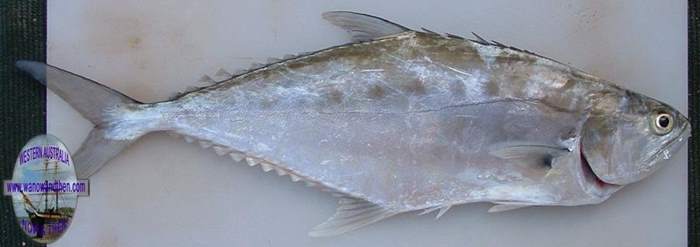
Name : Sand bass
Food Rating : *
Usually caught : From boats with light gear and small hooks.
Habitat : Weedy areas with sandy bottoms.
Found : Northern waters.
Notes : Not a good fish to eat as the flesh is soft and tasteless.
These are caught in areas with weed over sandy bottoms.
Our Experiences : We have caught these in areas like Bush Bay when fishing for other types of fish in deep channels
that are surrounded by weed beds. Usually caught on fairly light tackle with small to medium hooks. We have occasionally
caught them on inshore reefs as well.
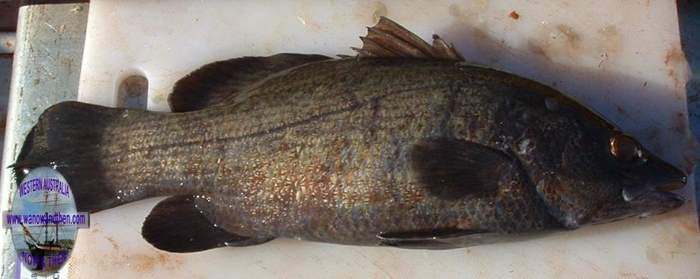
Name : Scad - Yellow tail
Food Rating : **
Usually caught : From jetties.
Habitat : Open sea.
Found : Southern waters.
Notes : Although they can grow to a reasonable size, most of the scad caught are only about 6 inches long.
Although they can be eaten they aren't highly regarded as table fare.
Our Experiences : Most of the time we have caught these when fishing from jetties using light gear with small hooks.
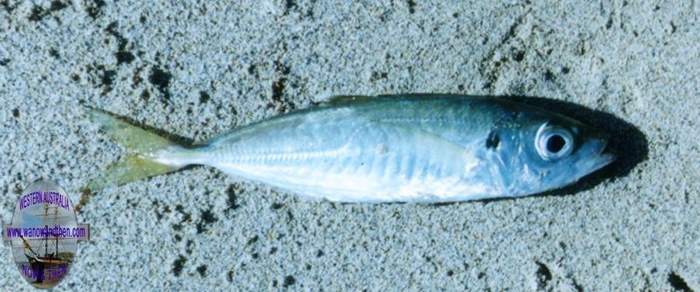
Name : Sergeant Major
Food Rating : *
Usually caught : From boats with light gear and small hooks.
Habitat : Usually over reef.
Found : Northern waters.
Notes : This is just accidental catch when fishing for other species.
Our Experiences : We often wonder how these fish managed to hook themselves as they have such small mouths.
Whenever we have caught them we let them go.

Name : Shark
Food Rating : **
Usually caught : Just about anywhere with heavy line, trace and big hooks.
Habitat : Everywhere.
Found : All waters.
Notes : We never target sharks as to me they always seem to taste of ammonia. They are found all around the coast and in
rivers and creeks so sooner or later we know we will hook them. They fight hard and are difficult to handle.
Our Experiences : To be honest we regard sharks as a nuisance and try not to catch them. We have not caught many and
after finding they were not good eating, we usually put them back these days.
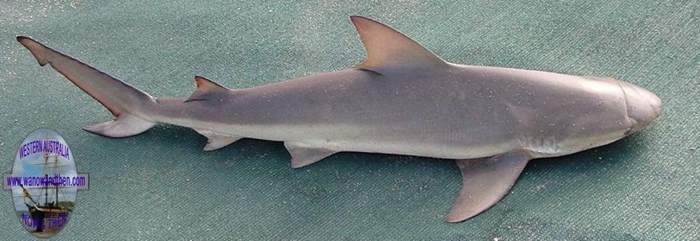
Name : Shovel nose ray
Food Rating : **
Usually caught : From a boat using medium to heavy gear.
Habitat : Shallows sand flats and tidal creeks.
Found : Warmer waters.
Notes : We don't kill shovel nosed rays so can't comment on their taste.
They are often called 'shovel nosed sharks' because of their body shape but they are in fact a type of ray.
Our Experiences : We have hooked these accidentally when fishing in shallow areas for other species. They are bottom feeders and put up
a fairly good fight. We always release them.

Name : Sole
Food Rating : ****
Usually caught : By drift fishing along the bottom.
Habitat : Sand with weed nearby.
Found : Southern waters.
Notes : Lives in a similar manner to flounder and flathead (above) by lying in wait on the bottom and ambushing their prey.
They are a good eating fish but like flounder are hard to fillet. Many people don't bother to fillet them.
Our Experiences : Caught by drifting over sandy patches near weed beds. Small baits like prawn on a small hook
work well.
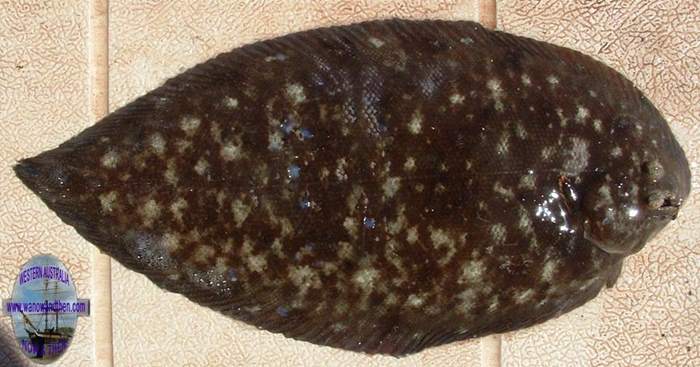
Name : Spinefoot
Food Rating : Read the text
Usually caught : From a boat over reef.
Habitat : Reef.
Found : Northern waters.
Notes : Spinefoot are also known as rabbit fish and happy moments. They have a number of venomous spines and
it you are spiked they cause intense pain. Try not to handle these fish, simply cut your line and let them go.
Our Experiences : We have caught a number of these in the north west and even though we have been told they make good
eating, the chance of getting spiked is not worth the risk. We just cut our lines without bringing the fish into the boat.
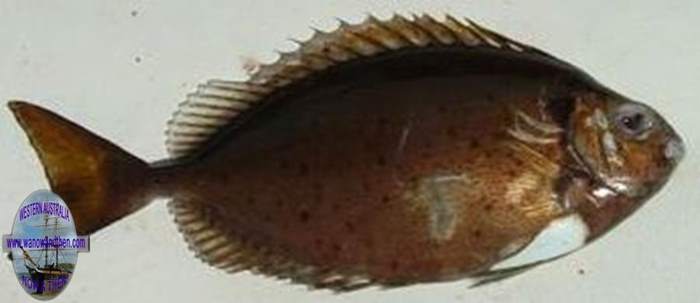
Name : Sweetlip
Food Rating : **
Usually caught : From a boat over reef.
Habitat : Reef.
Found : Northern waters.
Notes : These are only average eating quality but they grow quite large and fight well.
Our Experiences : Generally we have caught these in warmer weather and they seem to disappear in the cooler months.
We have normally caught them when fishing over reef for emperor.
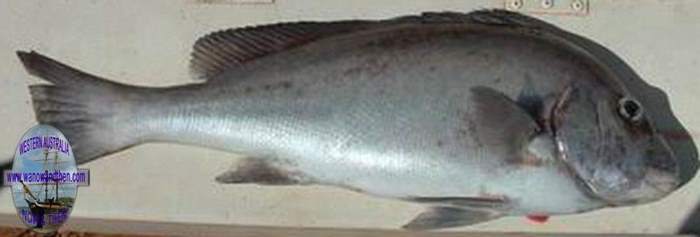
Name : Tailor
Food Rating : **
Usually caught : Trolling from a boat or casting from the beach.
Habitat : Tidal rivers and shoreline.
Found : Southern waters.
Notes : Tailor are fast aggressive fish that like to take moving bait. hey have a mouth full of large teeth so be careful
when handling them.
Tailor grow quite large and can be good eating if they are cooked the same day they are caught.
Our Experiences : We have caught tailor mostly by casting from the beach using a strong line with a light wire trace and
a ganged hook. Others catch them by trolling lures behind boats.
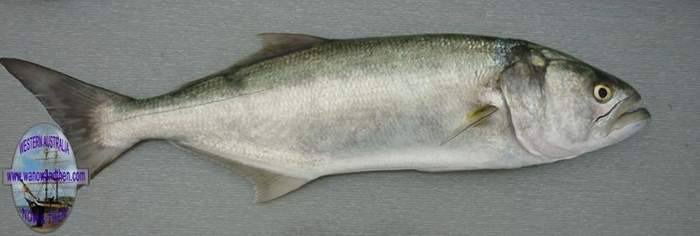
Official Fisheries ID charts here
Name : Tarwhine
Food Rating : ***
Usually caught : From boats, shore or jetty.
Habitat : Tidal rivers and shoreline.
Found : Southern waters.
Notes : Tarwhine are often mis-identified as bream and in fact they are sometimes called silver bream.
They are good eating and are a popular species for anglers as they can put up a good fight.
Our Experiences : Although they can range as far north as the Gascoyne, we mostly catch tarwhine in the south west from Perth
to Esperance. We have caught them from the boat and from rocky shorlines with light gear and small to medium sized hooks.
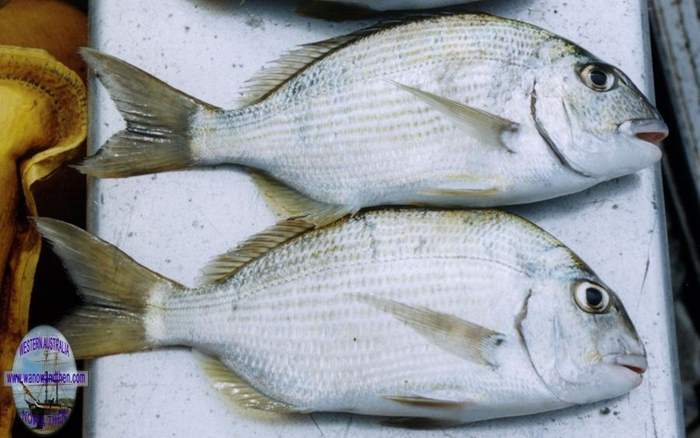
Name : Threadfin
Food Rating : *
Usually caught : From boats, shoreline or creek banks.
Habitat : Tidal rivers and shoreline.
Found : Northern waters.
Notes : There are different types of threadfin but we are not impressed with their eating quality as they are very
strongly flavoured.
Bigger specimens are very strong and move fast. When they hit your line they will take off for a good run
and you have to fight to control them.
Our Experiences : We have caught small threadfin from sandy shorelines but the larger ones we have usually caught
in tidal creeks. Don't underestimate their strength as one large 'thready' ripped a rod holder from our boat and we
almost lost the rod over the side. The picture below shows a blue or blue nosed threadfin. The other type grows even
larger and is called a king threadfin. The king threadfin typically has yellowish fins and more prominent thread structures.
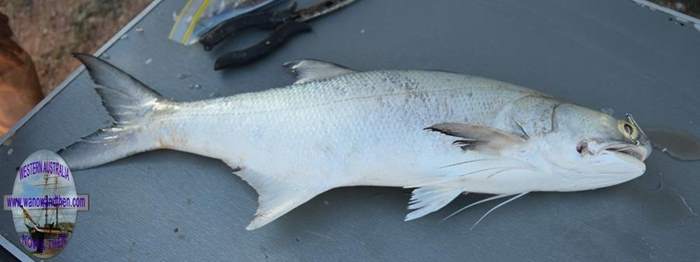
Name : Trevally
Food Rating : *
Usually caught : From boats, shoreline, rocks or creek banks.
Habitat : Open sea.
Found : See text.
Notes : Trevally are often called 'neighbour fish' because the larger ones are impressive to look at but
not much good to eat so people catch them and give them away.
The bigger trevally are found in the north west and pound for pound they are some of the strongest fish you
will ever hook. When handling them, beware of the sharp area near the tail.
Smaller varieties, notably skip jack (skippy) are found in southern waters and people often do eat them
even though they are quite strongly flavoured.
Our Experiences : If big trevally are 'on the bite' they will simply wear you out. They are fun to catch but
you will wind up with aching arms and shoulders after catching two or three. For the big species we use heavy lines
wire traces and big ganged hooks.
A few different types of trevally are shown below, hover over each picture for the names.
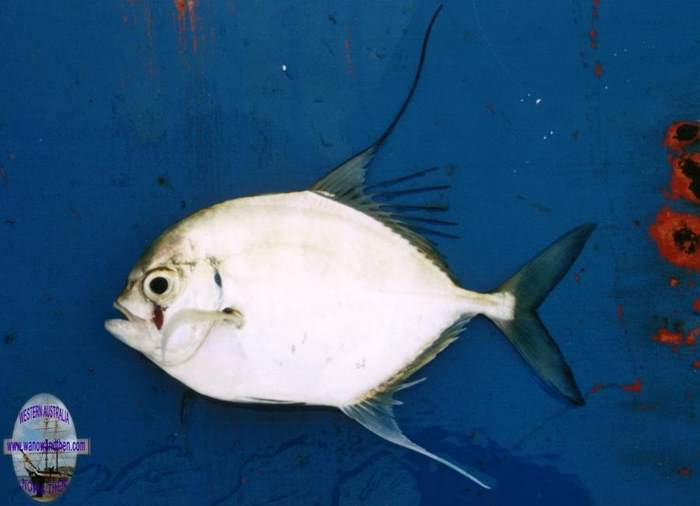
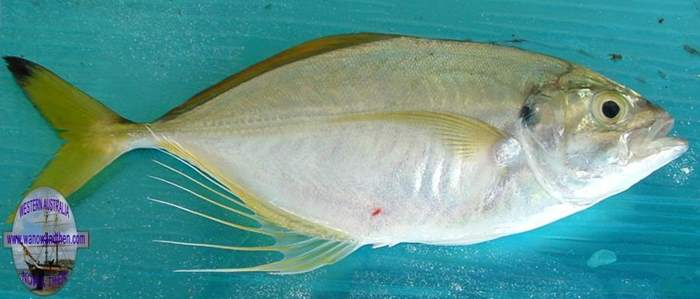
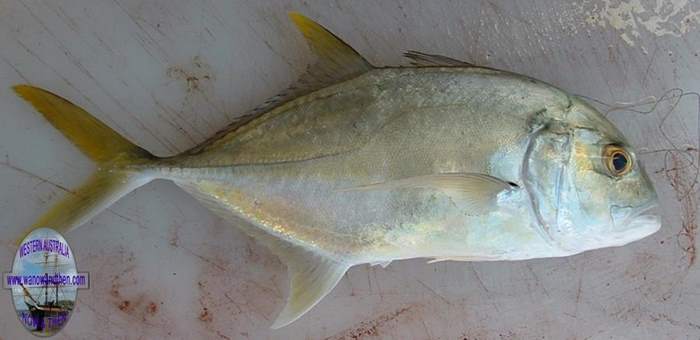

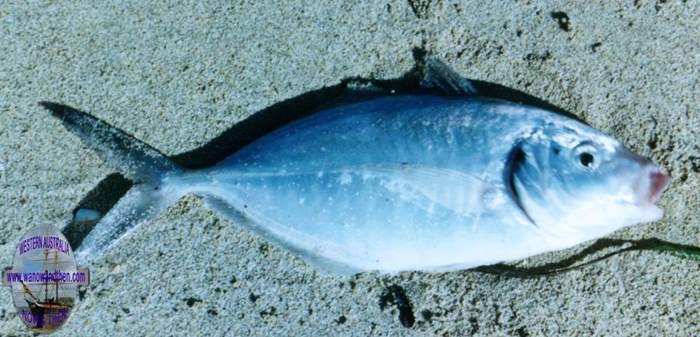
Name : Trumpeter
Food Rating : *
Usually caught : From boats, shoreline or jetty.
Habitat : Open sea and shoreline.
Found : Southern waters.
Notes : Although some people actually eat these fish we really can't understand why because they are pretty awful.
They are basically a 'nuisance fish' that hang around in huge schools and strip your bait before other fish get to it.
Our Experiences : We catch these very often even though we don't want to. Some of them are unlucky and end up
being fed to local pelicans and terns. We usually catch them when fishing for whiting.
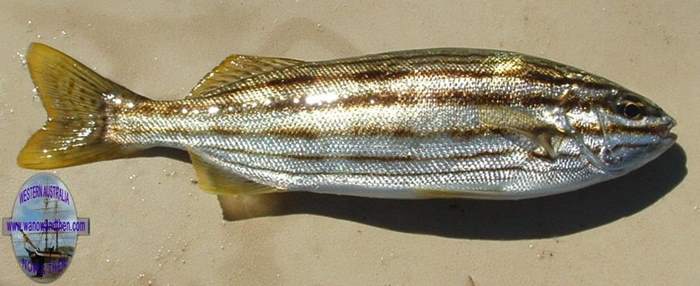
Name : Tuna - Long trailed
Food Rating : **
Usually caught : From boats.
Habitat : Open sea.
Found : Northern waters.
Notes : Not a good eating tuna, the long tail will put up quite a fight if hooked.
If you intend to eat one you need to bleed it as soon as it is caught and it will make a mess and they are full of blood.
Our Experiences : We have only ever caught one long tailed tuna and it was hooked when we were float line fishing for mackerel.
This particular one grabbed a small hardy head even though it already had a stomach full of fish.

Name : Tuskfish
Food Rating : ***
Usually caught : From boats.
Habitat : Open sea over reef.
Found : Northern waters.
Notes : There are a number of different types of tuskfish and the most highly prized is the baldchin groper.
Tuskfish are prized as an eating fish but to be honest we find them rather tasteless and soft.
Our Experiences : We normally catch the blue tuskfish when fishing for snapper and we find them quite annoying
as they are all - without exception - undersized.
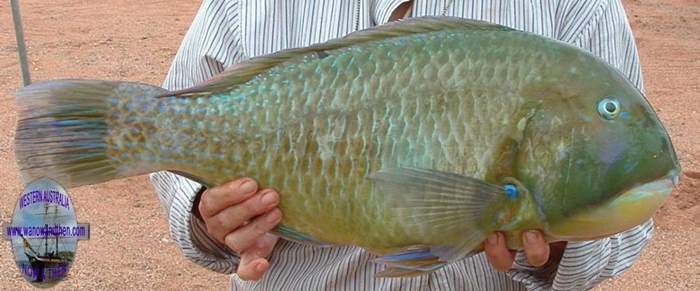
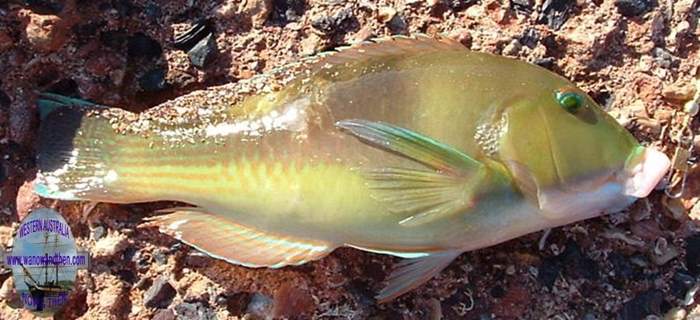
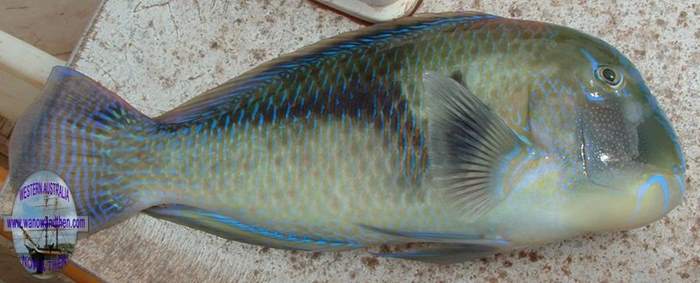
Name : Whiting
Food Rating : ****
Usually caught : From boats, jetties and shoreline.
Habitat : Coastal areas over sand.
Found : All waters.
Notes : There are a number of different types of whiting and without a doubt the best eating quality are the yellowfin variety.
These are followed by the sand or school whiting and King George whiting.
Most anglers are familiar with small whiting caught near the shoreline but there are much bigger fish in deep water further out to sea.
Our Experiences : We have caught whiting in southern waters and up north so they are found along most of the coastline. King George seem to stick to southern
waters as do school whiting but yellowfin are more common up north. Whiting LOVE worms so if you can get fresh worms then you will catch
plenty of fish. They also like prawn so that is a good alternative. We have met people who catch whiting on small lures but we
have never had any success that way. Usually a small long shank hook, 6lb line and a small split shot weight is the only gear we need. The weedy whiting shown below are no good to eat.

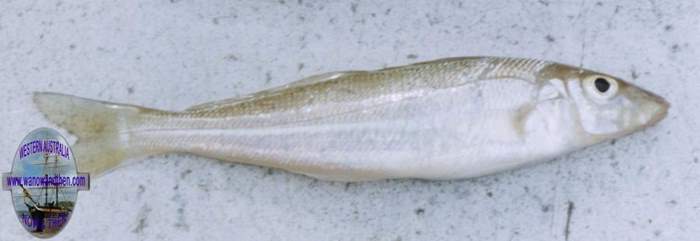

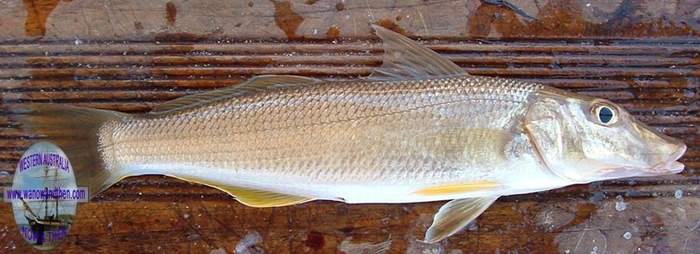
Name : Wrasse
Food Rating : **
Usually caught : From boats.
Habitat : Coastal areas over reef and near weed.
Found : All waters.
Notes : There are too many types of wrasse to discuss properly but many are rather soft and tasteless.
Our Experiences : Wrasse are common along the coast and are usually caught near either weed or reef. They aren't much of a fighting fish and
we usually let them go.
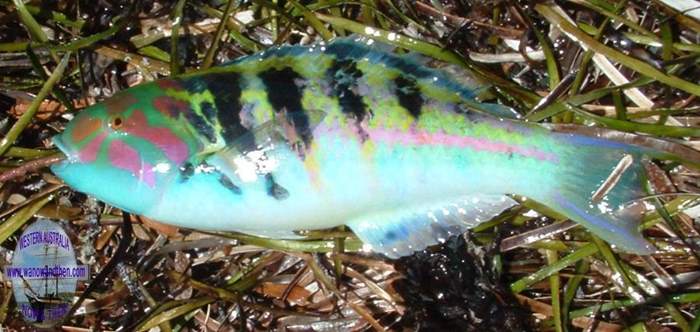
Official Fisheries ID charts here
|

















































































